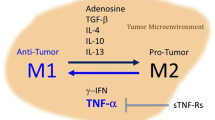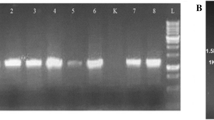Abstract
Group B streptococcus (GBS) isolated from human neonates diagnosed with sepsis and respiratory distress produces a polysaccharide exotoxin (CM101) which has been previously described as GBS toxin. CM101 infused i.v. into tumor-bearing mice causes rapid tumor neovascularitis, infiltration of inflammatory cells, inhibition of tumor growth and tumor apoptosis. CM101 has successfully completed phase I studies in refractory cancer patients with very encouraging results. We have now demonstrated a mechanism of action for CM101. Using a normal mouse tumor model, we have examined tumor and normal tissues which were harvested at 0, 5, 15, 30 and 60 min post-infusion of either CM101 or dextran. We present evidence that CM101 is rapidly (within the first 5 min) bound to the tumor neovasculature. Complement is activated by the alternative pathway (C3) and leukocytes start to infiltrate the tumor within the first 5 min. Through RT-PCR and immunohistochemical techniques, we demonstrate that proinflammatory cytokines, interleukin-6 and tumor necrosis factor (TNF)-α, are up-regulated in infiltrating leukocytes and TNF receptor 2 is up-regulated in the targeted tumor neovasculature. Combined, these events constitute possible explanations for the observed pathophysiology of tumor ablation.
Similar content being viewed by others
References
Hellerqvist CG, Rojas J, Green RS, et al.Studies on group B β-hemolytic streptococcus. I. Isolation and partial characterization of an extracellular toxin. Pediatr Res1981; 15, 892–898.
Rojas J, Green RS, Hellerqvist CG, et al.Studies on group B b-hemolytic streptococcus. II. Effects on pulmonary hemo-dynamics and vascular permeability in unanesthetized sheep. Pediatr Res1981; 15, 899–904.
Sandberg K, Edberg KE, Fish W, et al.Thromboxane receptor blockage (SQ 29548) in group B streptococcal (GBS) toxin challenge in young lambs. Pediatr Res1994; 35, 571–579.
Rojas J, Larrson LE, Hellerqvist CG, et al.Pulmonary hemodynamic and ultrastructural changes associated with group B b-hemolytic streptococcal toxemia in adult sheep and newborn lambs. Pediatr Res1983; 17, 1002–1008.
Hellerqvist CG. Therapeutic agent and method of inhibiting vascularization of tumors. US Patent 5,010,062, April 23, 1991.
Sundell HW, Yan H-P, Wu K, et al.Isolation and identification of group B beta-hemolytic streptococcal (GBS) toxin from septic newborn infants. Pediatr Res1997; 39, 302A.
Hellerqvist CG, Thurman GB, Page DL, et al.Antitumor effects of GBS toxin: a polysaccharide exotoxin from group B b-hemolytic streptococcus. J Cancer Res Clin Oncol1993; 120, 63–70.
Thurman GB, Russell BA, York GE, et al.Effects of GBS toxin on long-term survival of mice bearing transplanted Madison lung tumors. J Cancer Res Clin Oncol1994; 120, 479–484.
Hellerqvist CG, Thurman GB, Russell BA, et al.Anti-tumor effects of GBS toxin are caused by induction of a targeted inflammatory reaction. In: Maragoudakis ME, Gullino PM, Lelkes PI, eds. NATO/ASI Series — Angiogenesis: Molecular Biology, Clinical Aspects, Series A: Life Sciences. New York: Plenum 1993; 263, 265–269.
Thurman GB, Page DL, Wamil BD, et al.Acute inflammatory changes in subcutaneous microtumors in mice ears induced by intravenous CM101 (GBS toxin). J Cancer Res Clin Oncol1996; 122, 549–553.
DeVore RF, Hellerqvist CG, Wakefield GB, et al.A phase I study of the antineovascularization drug CM101. J Clin Cancer Res1997; 3, 365–372.
Wamil BD, Thurman GB, DeVore RF, et al.Soluble e-Selectin in cancer patients as a marker of the therapeutic efficacy of CM101, a tumor inhibiting agent, evaluated in phase I clinical trial. J Cancer Res Clin Oncol1997; 123, 173–179.
Vetvicka V, Thornton BP, Ross GD. Soluble betaglucan polysaccharide binding to the lectin site of neutrophil or natural killer cell complement receptor type 3 (CD11b/CD18) generates a primed state of the receptor capable of mediating cytotoxicity of iC3b-opsonized target cells. J Clin Invest1996; 98, 50–61.
Hellerqvist CG, Lloyd S, Wang E, et al.Modulation of interleukin-12 mRNA expression in leukocytes of cancer patients treated with CM101. Ann NY Acad Sci1995; 795, 346–348.
Fu C, Carter CE. Detection of circulating antigen in human schistosomiasis japonica using monoclonal antibody. Am J Trop Med Hyg1990; 42, 347–351.
Oncor. In Situ Apoptosis Detection1994.
Sambrook J, Fritsch EF, Maniatis T. Molecular Cloning-A Laboratory Manual, 2nd edn. Cold Spring Harbor, NY: Cold Spring Harbor Laboratory Press 1989: 10.51–10.69.
Liszewki KM, Atkinson JP. The complement system. In: Paul WE, ed. Fundamental Immunology, New York: Raven Press, 1993: 917–939.
Ochs HD, Nonoyama S, Zhu Q, et al.Regulation of antibody responses: the role of complement and adhesion molecules. Clin Immunol Immunopathol1993; 67, 33–40.
Ward PA. Role of complement, chemokines and regulatory cytokines in acute lung injury (Review). Ann NY Acad Sci1996; 796, 104–112.
Parkinson DR. Present status of biological response modifiers in cancer. Am J Med1995; 99, 545.
Donato NJ and Perez M. Tumor necrosis factor-induced apoptosis stimulates p53 accumulation and-21 WAF1 proteolysis in ME-180 cells. J Biol Chem1998; 273, 5067–5072.
Hellerqvist CG, Wang E, Wamil BD, et al.Evidence of induced apoptosis in cancer patients treated with CM101. Proc Am Soc Clin Oncol1997; 16, 546a.
Hellerqvist CG, Yan HP, Carter CE, et al.Identification of GBS toxin in neonatal fluids from group B streptococcus (GBS) infected neonates. Proc Am Soc Microbiol1996; B-348, 215.
Hellerqvist CG, Yan HP, Carter CE, et al.CM101 induces a complement-activated inflammatory response targeting tumor neovasculature. Proc Am Ass Cancer Res1996; 73, 487 (abstr 3328).
Author information
Authors and Affiliations
Rights and permissions
About this article
Cite this article
Yan, HP., Carter, C.E., Wang, Ez. et al. Functional studies on the anti-pathoangiogenic properties of CM101. Angiogenesis 2, 219–233 (1998). https://doi.org/10.1023/A:1009258801899
Issue Date:
DOI: https://doi.org/10.1023/A:1009258801899




